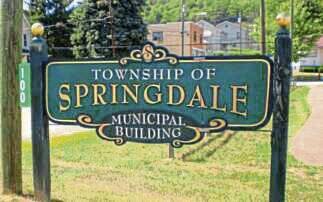Springdale Township to replace water meters, check lateral lines for lead
Springdale Township officials will collect data on materials used in residential and commercial water connections when new meters are installed.
The township commissioners agreed to include an advisory about that in letters being sent to residents whose old water meters are scheduled to be replaced with new remote-read meters.
Commissioner Tim Basilone suggested collecting the data to start the township’s effort to comply with a new rule from the state Department of Environmental Protection that requires all community water systems to identify the materials used in the lateral lines that move water from the water mains along the streets into homes and businesses.
“Every property has to be assessed as to whether it’s copper or lead,” Basilone said, referring to the lateral line. “We have to catalog each and every property.”
According to information provided by the DEP, the Lead and Copper Rule Revised was published in 2021.
It’s part of a campaign to address lead contamination in drinking water and reduce lead exposure to better protect public health.
It calls for communities to survey and inventory data on the lateral lines so those made of lead or galvanized pipe that may contain lead can be targeted for sampling and replacement.
Such lines can be owned by the property owner, the water system or both, according to the DEP.
Exactly what the cost, if any, to the home or business owner might be to replace such lines is not spelled out.
The rule states, however, that the Bipartisan Infrastructure Law passed by Congress will provide Pennsylvania with about $87 million a year over the next five years for lead service line replacements and inventory development.
Lateral lines will be categorized as lead, galvanized pipe requiring replacement, non-lead pipes and lead status unknown.
Communities must submit their inventory of lateral lines to the DEP by mid-October 2024.
Collecting that information in conjunction with the township’s meter replacement program makes sense, Solicitor Craig Alexander said.
“It’s just easier because you are going to be there for the meters anyway,” he said.
The DEP rule requires verification through a number of different methods. They include field verification, such as a visual inspection at access points of the line, camera imaging on the line and excavation.
Others involve the use of records, such as those indicating the installation or replacement date of lines after Jan. 6, 1991, when the state banned the use of lead in them. Other options include reviewing records of when neighborhoods were built and water sampling.
In some cases, two methods could be needed for verification.
“You have to verify what’s coming off the curb and what’s going into the house,” Basilone said, adding that a certified statement is required from an inspector.
One resident asked if homeowners can reject participation in the survey if they don’t want to replace their lines.
Basilone said that is really not an option. If they were to do that, it likely would come back to bite them when they want to sell or remortgage their homes, since banks likely would not provide financing if they discovered the dwelling has lead in its lateral line.
“Right now, we have no leverage,” he said. “We have to comply.”
Remove the ads from your TribLIVE reading experience but still support the journalists who create the content with TribLIVE Ad-Free.

